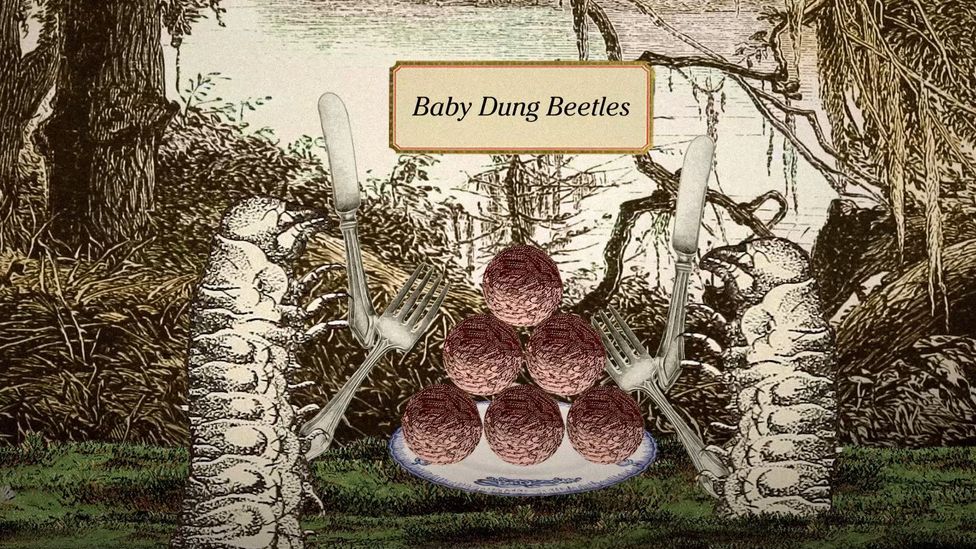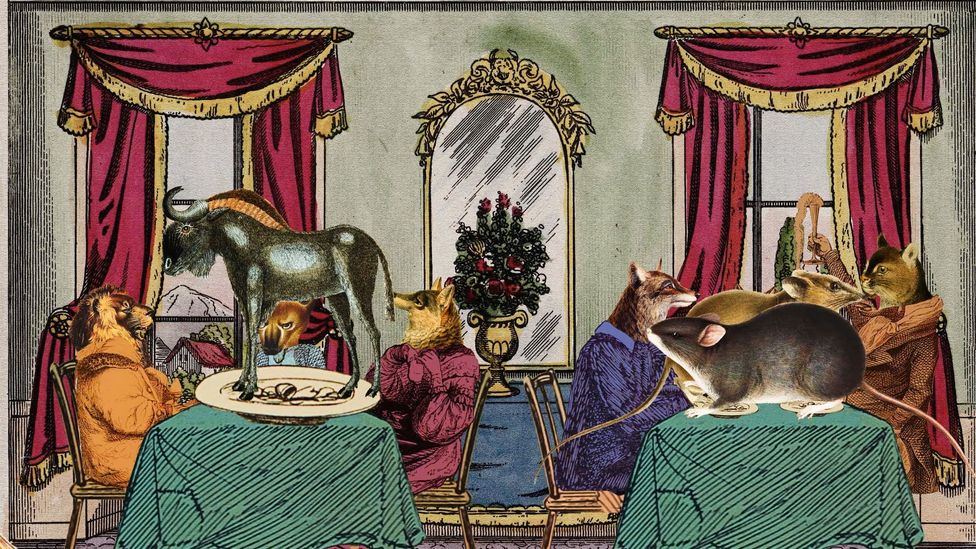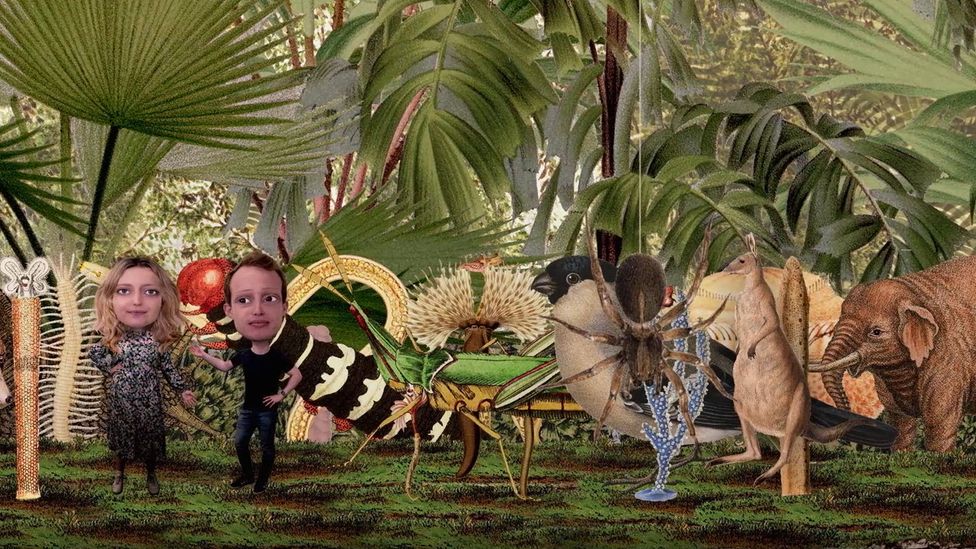There are good reasons that invertebrates are as small as they are – ecology and environment keep them in check. But there was a time insects were as big as crows. What happened to those lost giants?
F
From above the canopy comes a thundering sound, like the beating of 100 snare drums. The creatures hiding in the shadows between the trees, startled by the intruder, scatter across the forest floor. With the flash of an iridescent wing, the assailant dives for a wood-eating beetle, snatching it in its massive jaws before soaring away.
This giant killer is a griffinfly called Meganeuropsis permiana, named after the Permian period, from 299-252 million years ago. It is possibly the largest insect to have ever lived (certainly the largest flying insect in the fossil records) with a wingspan of 71cm (28in), which is twice the size of the largest dragonflies today (and probably would have been about the same size and weight of a modern-day crow).
The Permian was a period bursting with life, and much of it would have been familiar to us. There were amphibians, reptiles, fish and insects, while the dinosaurs were yet to walk the Earth. Sharks were the apex predators of the Permian seas, rather than the prehistoric marine reptiles like ichthyosaur and liopleurodon that later appear.
The top land predators in the Permian were therapsids – four-legged, carnivorous creatures with long jaws and razor-sharp teeth. While some of these, such as gorgonopsia, looked not dissimilar to large sabre-toothed rodents or small, stocky dogs, they were not mammals.
This was a period when giant insects reigned. M. permiana is one of many examples of Permian insects that outweigh their contemporaries. Other invertebrates reached giant proportions in the past too – Arthropleura, relatives of modern-day millipedes, reached more than 2m (6.6ft) in length weighed around 50kg (110lbs) and roamed the forests of the Carboniferous period 358-298 million years ago before dying out in the early Permian.
But what would happen if there were no constraints on the size of animals, and everything grew to be the same size? To answer this question properly, it is important to consider what restricts how large different animals can grow. (But you can learn what might happen if those restrictions did not exist in the video below).
What if all animals were the same size?
One hypothesis for how the insects of the Permian grew so large is that atmospheric oxygen levels were higher than they are today (they were as high as 30% in the Permian, compared to today's 21%). Insects breathe through spiracles – openings in the sides of their bodies – which lead to a network of tubes containing fluid, into which oxygen diffuses and then is taken up by the muscles.
"This is an inefficient way of breathing compared to the way that we breathe," says Tim Cockerill, a broadcaster and entomologist at Falmouth University in the UK, holding aloft a giant tropical fruit beetle from West Africa in the palm of his hand. "This is pretty much the size limit of most insects [today]. If insects were bigger than they are now, they just wouldn't be able to breathe in the same way (in 21% atmospheric oxygen)."
Might the environmental conditions have been just right for giant Permian insects? "If we look at that wiggly graph of oxygen levels going up and down over time, corresponding almost exactly is the size of the largest insects around that time as well," says Cockerill. But atmospheric oxygen levels alone might not be the only reason for the difference in insect sizes. The abundance of small prey and absence of birds (who were yet to feature in the tree of life), might also have allowed invertebrates to flourish.
The fossil record is full of examples of other prehistoric animals that would dwarf their modern relatives. Another such example is Jaekelopterus rhenaniae, a giant arthropod which grew to 2.5m (8.2 ft) long (picture an oversized woodlouse or pill bug with some vicious-looking claws) and existed in the Devonian period – about 100 million years before the Permian.
J. rhenaniae is sometimes called a ''sea scorpion'' because its long, segmented body with large claws at one end and a thin tail at the other gave it a passing resemblance to its modern relatives, which also include crabs, lobsters, spiders, millipedes, bees and ants. Unlike today's scorpions, which grow up to 20cm (8in) long, J. rhenaniae and its giant relatives were aquatic, which might be a clue as to how they were able to grow so large.
The largest modern arthropods are all marine-based, with the Japanese spider crab being the biggest, reaching 3m (10ft) from toe to spindly toe. Arthropods have exoskeletons – hard outer shells, which protect them from predators. They grow by shedding these exoskeletons to reveal a new, soft shell underneath. For larger species it can take hours or days for the new exoskeleton to harden, leaving the animal floppy and vulnerable.
On land, this limits how large an invertebrate can grow. Too big, and the new shell will deform under the effects of gravity. In water, however, the soft body is supported, allowing invertebrates to grow larger before their bodies become too unwieldy.
Vertebrates, like mammals and dinosaurs, are also limited in how large they can grow by physical forces. Being large makes moving harder, and takes more energy to generate the blood pressure needed to circulate blood through their systems. Even taking a breath becomes harder due to the effort needed to inflate lungs under the strain of a larger body.

Many invertebrates perform important roles within ecosystems, but if they were bigger it could disrupt that balance (Credit: BBC)
While the most massive animals on land are African elephants, the aquatic mammals are many times larger again. An adult blue whale, the largest animal to ever live, weighs around 180,000kg – or the same as 40 elephants. That size could only be achieved in water where movement is supported. Without the buoyancy of water, their organs can quickly be crushed by their own body weight.
Modern and prehistoric giants – such as whales, elephants and the long-necked sauropod dinosaurs – all tend to be herbivorous. In part, this is because of body heat and metabolism. Larger animals have a bigger surface area to volume ratio, meaning that an elephant, for example, has more volume compared to the surface area of its skin, whereas a mouse has far less volume compared to its surface area.
This means larger animals retain body heat far more effectively than smaller ones, which is one reason why mammals with a lot of volume, like elephants, rhinos and hippos, are relatively hairless and must cool themselves by other means, like mud baths.
Another reason is that their plant-based diet releases a lot of energy as heat during digestion. "Elephants are essentially giant walking fermentation vats, a giant dinosaur is basically a walking brewery, so they generate a lot of heat," says Kate Lyons, assistant professor of biology at the University of Nebraska, USA.
Sauropod dinosaurs – which include the colossal Argentinosaurus and Diplodocus – have air sacs along their skeleton like modern birds. "This does two things for the dinosaurs – it allows them to dissipate the heat that they're producing, and it also allows them to have lighter bones, but still have enough support for their mass," says Lyons. They evolved to their massive size because they were able to control the heat produced by digestion. (Learn what these massive animals may have sounded like.)
"But if you tried to take a sauropod dinosaur and make it the size of a shrew, it wouldn't survive," says Lyons. "And vice versa. If you tried to take a shrew with their metabolism and make it the size of an elephant or a dinosaur, it wouldn't work, because it just wouldn't get enough energy to survive."
The environment plays a role, too. Woolly rhinos and woolly mammoths, whose range stretched from northern Europe, through Siberia to North America during the Pleistocene ice age (2.5 million years ago to 11,000 years ago), needed their shaggy coats to cope with the cold temperatures. The fossil records show that numbers of megafauna like these peaked during the transitions between cold and warmer periods. At these times, food was more plentiful but it hadn't grown too warm for these large beasts. The Pleistocene also featured giant mammals that lived in warmer climes too, such as the giant ground sloth (6m/20ft from head to toe) from South America.
Why animals are the size they are has a lot to do with the environment, the food available to them, and the predators that surround them. But, what would happen if we played with those sizes? Hypothetically, if the size tables turned again, who would come out on top? Could giant invertebrates once again rule the planet?
When my colleague Amy Charles posed this question for the video earlier in this article, one of the first things we wondered is what would happen to all the poo. If all the small animals were made bigger, would we soon be inundated with faeces?
It is a bit disgusting to think about, but happily Cockerill and Lyons were on hand to answer this and some of our other idiosyncratic questions. They were also alarmed to think of the what the consequences of altering the size of animals would be in terms of the volume of number-twos.
But it's not just toileting that might descend into chaos. In the video, we venture into a world where all animals are the same size, to see how quickly our carefully balanced ecosystems would collapse.
One of the first things Cockerill wrestled with is whether a human-sized flea could jump over the Empire State Building. "There is something universal about the physics of animal sizes and the physics of muscles," he says. "As a muscle gets bigger it gets, relatively speaking, less powerful. So, the larger an animal, the less powerful its muscles for its body size. If we supersize a flea to the size of a kangaroo, it would probably only be able to jump as far as a kangaroo."

Most predators tend to hunt prey that are smaller than them, so if everything was the same size, they might then struggle (Credit: BBC)
This is because the proportion of the power of a muscle is relative to its cross sectional area – or the area of the muscle when sliced in half. No matter how big a flea could grow, there would be a limit to their jumping ability.
While there are some fundamental reasons that animals are the size they are, there is still some flexibility. One animal might end up growing much larger or smaller than another animal from the same species just a few kilometres away. This is sometimes described as the "island rule", where large animals become smaller on islands and smaller ones larger.
It might be the case that smaller animals – which tend to be lower on the food chain – are liberated on islands in the absence of their usual predators and grow larger than their mainland counterparts. While larger animals, restricted by the lack of things to feed on, shrink.
Gargano peninsula, which forms the spur on the back of Italy's boot, provides several examples in its fossil record. From the late Miocene to early Pliocene eras (around 5.3 million years ago), when the Mediterranean sea level was higher, Gargano was separated from mainland Italy, and the island was overrun with giant critters.
Hairy hedgehogs (also known as moonrats) dwarfed their mainland counterparts. One species, Deinogalerix koenigswaldi, had a 20cm-long skull. There were also giant hamsters (Hattomys gargantua), massive otters (Paralutra garganensis) and gigantic owls (Tyto gigantea, bigger than the largest species found today).
Elsewhere, a species of human – Homo floresiensis – is a possible case of island dwarfism. Dubbed "the hobbit" because of its diminutive size, the first example of a H. floresiensis was found on the Indonesian island Flores and is thought to be 95,000 years old. One theory is that H. floresiensis is a pygmy descendant of H. sapiens, or perhaps a dwarfed H. erectus. While its origins are unclear, these small humans seemed to thrive on only this island for thousands of years.
But, the evidence for the "island rule" is patchy (the biologist who first proposed it only suggested there are more examples that fit the rule than exceptions, but did not say it always applies). While it is a neat idea, it might just be the case that there is more flexibility in the size animals grow than we realise.
Just look at humans. In the tallest nation, the Netherlands, men reach on average 184cm (6ft) and women 170cm (5ft 7in), while in the shortest nation, Timor Leste, men stand at 160cm (5 ft 3in) and women 153cm (5ft). Diet and environment play a large part in why the Dutch have added 20cm (7.9in) to their average height in the past two centuries, but a big part is also played by sexual selection. Being tall in the Netherlands is more attractive, and so the Dutch keep getting taller. (Learn more about why the Dutch are the tallest people in the world on BBC Reel.)
Our H. floresiensis cousins, who were a tiny 106cm (3ft 5in), might be the result of the island rule – short because there was less around for them to eat. Or, they might be so small because being short was attractive to them. Or both, or neither.
While there is some flexibility in the size that humans can grow, let's be grateful that biology and physics keep things mostly in check. The topsy-turvy world that Lyons and Cockerill showed us might be a little too chaotic for me.
--
Join one million Future fans by liking us on Facebook, or follow us on Twitter or Instagram.
If you liked this story, sign up for the weekly bbc.com features newsletter, called "The Essential List" – a handpicked selection of stories from BBC Future, Culture, Worklife, Travel and Reel delivered to your inbox every Friday.
